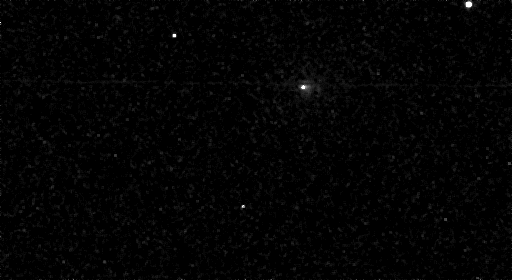Follow us on Google News (click on ☆)
Images taken by the CaSSIS instrument allowed for the creation of an animation showing the comet as a fuzzy bright spot crossing the field of view. This observation represents the closest view that ESA will obtain of this mysterious cosmic visitor.

Image captured by the Perseverance rover on October 4th, showing comet 3I/ATLAS as a bright streak in the Martian sky.
Credit: NASA/JPL-Caltech
The Mars Express orbiter, although properly positioned to observe the phenomenon, could not detect the comet due to its faint brightness. The Trace Gas Orbiter's instruments, originally designed to study the Martian surface from just a few hundred kilometers away, had to be used innovatively to capture this distant and fast-moving object. Researchers explained that the comet appeared approximately 10,000 to 100,000 times fainter than the instrument's usual targets, representing a true technical achievement.
The bright spot visible in the images corresponds to the comet's nucleus, a ball of ice and rock, surrounded by its coma - the cloud of gas that evaporates when the comet approaches the Sun. Although no tail is visible in the recent images, scientists expect it to develop and gradually brighten as the object approaches our star. October 30th will mark the closest point to the Sun for this comet, which should intensify its activity.
On the American side, the situation remains uncertain due to the shutdown of NASA's public communications during the U.S. government closure. However, a raw image captured by the Perseverance rover shows a bright, streaking object in the Martian sky that could correspond to the interstellar comet. Analyses are ongoing to determine if other spacecraft were able to observe this historic passage.

Animation of interstellar comet 3I/ATLAS created from images captured by the ExoMars Trace Gas Orbiter on October 3rd.
Credit: ESA/TGO/CaSSIS
3I/ATLAS represents the third confirmed interstellar object after 'Oumuamua and Borisov, and appears to be the largest identified so far, with an estimated diameter between 3 and 7 miles (5 to 11 kilometers). Its speed and trajectory indicate that it has been traveling through the galaxy for billions of years, making it an object older than our Sun itself. After passing behind the Sun, the comet will become visible again from Earth next December before permanently leaving our Solar System in March 2026.
Interstellar objects: messengers from other worlds
Interstellar objects like 3I/ATLAS are celestial bodies that are not gravitationally bound to our Sun and originate from other planetary systems. Their discovery opens a unique window into the composition and formation of distant stellar systems.
These cosmic travelers can be comets, asteroids, or planetesimals ejected from their original systems during gravitational disturbances. Their study allows astronomers to compare the materials that make up our Solar System with those from other regions of the galaxy.
Detecting these objects remains a technical challenge as they are typically small, faint, and move rapidly. Recent advances in telescopes and observation techniques have significantly improved our ability to spot them during their brief passage through our cosmic neighborhood.
Each new interstellar object discovered provides valuable information about the diversity of planetary systems in our galaxy and could even reveal planetary formation processes different from those observed in our own Solar System.